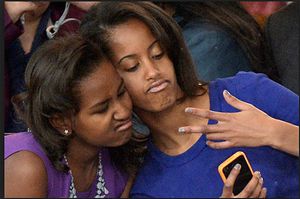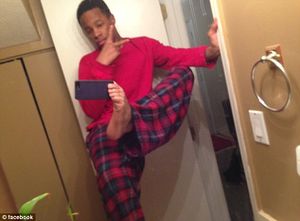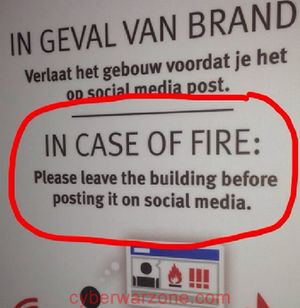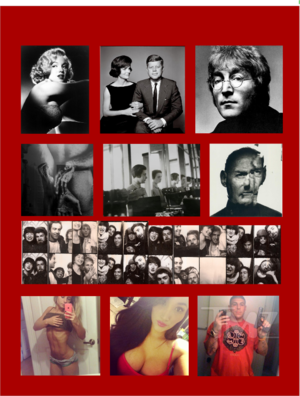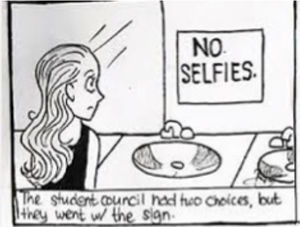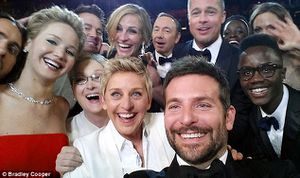User:Mihail Bakalov/Trimester 4/READING, WRITING AND RESEARCH METHODOLOGIES/MediaObject
The selfie is a sub-category of the self-portrait, which has being practised for a long time,
but the term was invented in the past 10 years. A selfie is a photograph taken of oneself, typically
done with a smartphone or webcam and uploaded to a social media website. The pictures
represent one's experiences usually promoting your self in a positive environment & attitude.
"The idea of the selfie is much more like your face is the caption
and you’re trying to explain a moment or tell a story." Frédéric della Faille, NY times , http://www.nytimes.com/2013/10/20/sunday-review/my-selfie-myself.html?_r=0
The fasination to our image comes from very early age and play's an important part of our identity. Infants by the end their second year start to recognise their image and establish the perception of their self by looking at their reflection in the mirror. This is what Jacques Lacan calles "the mirror stage" in his paper “The mirror stage as formative of the function of the I as revealed in psychoanalytic experience". The recognition in this phase induces apperception, turning oneself into an object that the child can view from outside itself. Afterwards their reflected image takes part as structural element of the psychic life, which becomes the foundation for the child's social relationships.
The selfie becomes such a referance as a reflection of the self. This kind of selfportrait not only acts as a reflection how people see you, but also allows to choose the way to be viewed. A selfie mandatory includes the person taking the picture, while with a self portret, he abstractly includes him self. This is the mirror where we can share with others. We perform in front of the camera to promote our selfs because we are dependent upon others for ours "I" stability and coherence. The selfie provides instant notion of what you are doing, where you are and how you are feeling, the same information as a written text. Our sociaty can be considered as a culture that rely on visual images, because we are surrounded with mediums that try to squize all kind of information into visual components like: the Internet, advertising, cinema and video games. No longer we need to write letters, you can just post an image containing current info about you and a tag which would be the title of the event. The established aesthetic trends direct the creation of selfies assimilating the human body as a canvas, getting rid of your self and accumulating a new look where symbols and objects are subscribing artificial agencies to the visual identity. The fall back of real personality and the allowing of becomimg something else following template behaviour leads to replaceability of personalities. The following of these modes of behaviour laid its way through social networks and was also helped by the development and integration of cameras in to mobile phones.
Twitter first asked: "What are you doing?,"
"What's on your mind ? , " "What's happening here? " [Geert Lovnik - networks without a cause - p12]
Social networks first promoted this type of behaviour and opened their hands
for user generated content.
For example Facebook has certain capabilities of providing space as a blog,
where you post your likes, social field where to self-perform and a social
network where to communicate with others. This is where the selfie
found its perfect habitat as such images replace the slow text elaboration.
The technology needed to create and share these pictures are integrated into
accessible mobility devices which we use daily. It has gotten more easier to
take part in such activities as these devices offer the immediacy of sending
information and receiving respons.
The design of the social platforms fitted bestly nowadays society based on
short attention span, because today's growing amount of data provokes a
large time consuming process while browsing through the content and trying
to keep up with the pace of data overload.
If people want to depict their current mood, situation they take a picture of
them selfs which allows the immidiate grasping of information. This led
to the eruption of online platforms as dairys which contain only photographs,
such as Instagram. The practise
of sending such information around social networks has turned it into
a self-promotion, which takes place anywhere you go and it
takes up also our leisure time.
This is the algorithmic logic of the chat line, the online community or
self-performance through email and social networking activity, areas
in which self-performance is necessary to be part of any particular
discourse within the economy of information. [Steve Rushton - Masters of media - p77]
The social environment also provokes back the user
to feedbackto the connection, offers an alternative reward system.
As creating content makes you socialize with others and in return we get
likes. Social networks push users to desire secondhand information about themselves.
We use social networks to elevate ourselves and instagram helps us to position
selfies as the center of our univers. We have moved from an internal oriented
culture to an exterior, focused on presenting and marketing ourselves.
With selfies the camera which is easily operatable and lacks all the
needed adjustments needed to produce a photograph, turns into the
mirror.An example of devices that share the idea of the selfie and its visual
aesthetics but record on a different medium is the hero camera.
The self-referencing in GoPro videos
establish them as a particular genre. The statement from Ben Valentine
in the thenewinquiry.com presents the idea of the producer GoPro
changing from a camera company to a lifestyle company.
It's an automatic unadjustable camera that provides thought-free process
which is enchanced by it's design, to be worn rather than
to be operated.
"GoPro’s emphasis on a panoramic first-person image addresses that
need, filling a niche neglected by ordinary smartphones." Ben Valentine
An outcome from this type of exposer of the self is that
no matter what you are filming, GoPro interpolates you as the subject.
The narcistic representation is inscribed by default and is no longer
produced as an option.
A similiarity in the aftermath of the mass use of the selfie turns itself from photography as a practise to becoming of a performative action, can be seen also in the hero cam. Both of these self-centered ways of depiction have in their nature the immidiat distribution to the public domain. This turns the material not to be remembered but for viewing on a digital platform. We caption the produced visual material with hashtags as an essential element of the sharing system. It has become very popular to use viral hashtags to make your content more visible. These particular captions have being created and filled up by other people's performative actions. This puts the visual material to categories which are fed from the feedback that the design of online social networks provide. This is where the concept of get rid of your self comes into place. Selfies in these groups present certain behaviour which is being replicated by different users, who present an amplification of them selfs. The practise of tagging becomes part of a strategy for self-promotion that allows the individual to rise above the anonymity of most users, but can only stand out by attaching a popular tag. Rendering the person as part of a group, focusing on the enhancing of the same part of them selves, thus becoming an object representing the amplified part. Users create many digital selves with many different looks, compulsively abstracting their images- to become even more fascinated with themselves – but in the end forming separate identities. All the uploaded data forms our network character which is not an extention of us because it's altered by the participatory performative actions we take and the profile that is formed is disatached from the real personality becoming external individuality.
This self-promotion has become even mandatory as some businesses
use selfies to to shrink the distance between the seller and the consumer.
stand for showing personality, dedication to work and giving social proof
from the side of the salesman. Finding appliance for acting as a perfect
advertisement and recommendation that to other prospects need. So
this kind of self portrait from the reflection that gives stimulation to the self
revolved into the use of business promoting strategies.
The selfie is a media object, a form of visual self-expression that grabs together elements of sharing experiences, personal view, emotions and desires.The similar aesthetics of the selfie leave away social statuses and other society layered distinctions. The established aesthetic trends direct the creation of selfies assimilating the human body as a canvas, getting rid of your self and accumulating a new look where symbols and objects subscribing artificial agencies to the visual identity. In some groups of selfies
Getting rid of your self Leaving behind the real personality and allowing it to become something else. This leads to replaceability of personalities. Portrait photography has undergone a process of transformation where the selfie has established it self as the preferred way of portraying ones self. The performative alteration and the integration of it in daily life during the past years laid its way through social networks and was also helped by the development and integration of cameras in to mobile phones.
The selfie provides instant notion of what you are doing, where you are and how you are feeling, the same information as a written text. No longer need to write letters, you can just post an image current info about you and a tag which would be the title of the event. The immediacy of it matched perfectly the vastness of nowadays society. This all has led to the gathering of a culture around it, it has arose as a cultural product, part of on-line positive culture and backed up by it. People participating in on-line social network take part of this typical culture behavior, because the platforms are design towards this direction. The imaginary realm of 24/7 performance grabs participants with it's accessibility and feedback. This is where a certain bubble forms of on-line, users with similar ideas, likings and sphere of knowledge bringing them together and trapping them in this closed environment of similarities. The result of it is we end up being alone together.
I find interesting the points were the selfie is used to depict personal experiences in a very specific(new) way and to create online identity. What is the weight of someones personal(narcissistic) opinion about him self being represented only by his appearance in a photo?
The emergence of this type of photography and as becoming viral how does it affect the visual dictionary of young people? Also what kind of place in society do these images get and establish them selves?
The performative aspect of the imaginary realm, presention of a wide extensiveness of activities in connection/comparison to the less and less strive towards content of specific repetitive practices or serious pursuits. To what extent can a photo represent the whole experience that a person is having?
A selfie is a photograph taken of oneself, typically done with a smartphone or webcam and uploaded to a social media website. The pictures represent one's experiences usually promoting your self in a positive environment & attitude.
"A subversive form of self-expression that narrates one's own view of desirability.
In this sense, selfies can be empowering and offer a way of actively asserting agency." wikipedia-selfie article
The selfie is a sub-category of the self-portrait, which has being practised for a long time, but the term was invented in the past 10 years. The journal side of the selfie plays a huge role in making it become so viral. Nowadays whenever a person, especially a tourist sees something nice, he/she positions him/her right in front of it and takes a picture.
Selfies have become the catchall term for digital self-portraits abetted by the explosion of cellphone cameras and photo-editing and sharing services. Every major social media site is overflowing with millions of them. Everyone from the pope to the Obama girls has been spotted in one. The idea of the selfie is much more like your face is the caption and you’re trying to explain a moment or tell a story.
"Narcissus, who after glimpsing his reflection in a pond,
falls so deeply in love with it he is unable to leave –
eventually perishing." Erin Cook
No need to talk that there are two sides of this phenomenon. It's fun to take photos of ourselves, stick a filter on them and think of a gag caption before waiting for push notifications from friends remarking . We have immediate access to photos in a way that has never existed before which would have a drastic change on our visual dictionary
Nonetheless this kind of self-portrait might have arose in public on-line spaces, now is used everywhere in customer engagement. For example the idea has being taken up by businesses which think It would stand for showing personality, dedication to work and giving social proof from the side of the salesman. Finding appliance for acting as a perfect advertisement and recommendation that other prospects need. Making marketing use of something viral which people are accustomed to.
"In the future everyone will be famous for 15 min." Andy Warhol
The transmission of information nowadays helps spreading our own images, but also broadens our visual dictionary, because of the wide access to data. Although the gigantic amounts of info we are still facing template culture problems. The selfies has certain models which they follow,
The same way as many " users of blogs" do not conform to larger ideals but display a culture of " detached engagement" the same is happening to the social eruption of selfies.
"Jodi Dean argues that a new form of " communicative capitalism"
has emerged, where discourse proliferates but is completely devoid
of genuine political potency. Finally, rather than foster new public
engagements, online discussion tends to take place within " echo
chambers " where groups of like-minded individuals, consciously or
not, avoid debate with their cultural or political adversaries."
Networks without a cause - Geert Lovink
We have moved from an internal oriented culture to an exterior, focused on presenting and marketing ourselves.
Famous people use selfies as a way to bring them down to a normal persons status quo, on the same level, althout most selfies from celebrities are being digitally retouch, so they are directed towards a enhanced promotion(campaign) of their selves
"The moving away of the anonymity - people create template images which differ only in content exluding the person in the picture. creating trends in certain behavour in front of the camera, making specific face mimics, behaviour and camera position." http://selfiecity.net/
Facebook has certain capabilities of providing space as a blog, where you post your likes, social field where to promote your self and a social network where to communicate with others. This is where the selfie found its perfect habitat. The 24/7 performance led to the collapse between what is pretending and what is reality. Now as this acting is taken in account from governmental/educational/financial institution the acting has grown in purpoce.
The DIY concept of this type of photos makes them accessible but also provokes vitriolic backlash stems from the fear of who is both in front of and behind the camera.
The aspects of photograph, isolating only one frame of reality, taking out the past and the future out, thus creating another meaning of the moment. It could be fake or manipulated. Perfectly creating an opportunity to get rid of our selves and shed a light on presenting our selves.
The limitations of adequate presentation of photography and video mediums can be compared to the television talk-shows which present people who are telling the story how it really happened.
–-----------------------------------
James Franco defends the self-portrait stating they should not be seen as an egocentric act, but instead a journalistic moment as it cultivates a "visual culture, the selfie quickly and easily shows, not tells, how you're feeling, where you are, what you're doing", much like a photojournalist image. ( NY times magazine 2013/12/29 )
1 First the experience when you go to a photography studio to take your portrait. During this process the person has a certain distance in behavior when standing in front of the camera, being camera shy or difficulties in communication. The model has to pose, perform in a closed environment in front of the photographer, who is trying to capture something private or natural from the poser.
2 photobooth This is where the shyness in front of the camera is overcome. Also the amount of time that takes to be accomplished has shrank tremendously. The performative state is done in a closed environment and the outcome is a limited number of unique images which are only to be shared with few people or kept for oneself.
3 selfies almost the same without the limitation part. unlimited amount of copies. has no space/time boundaries. Gives pulbic distribution of the images allowing instant visibility.
[Steve: why are selfies important to you?
make annotation of the texts you are using here, take the text out of the sketch status and write about your subject. 1st step - annotate the texts you have found and formulate an argument using those texts.]
I find interesting the points were the selfie is used to depict personal experiences
in a very specific(new) way and create identity. What is the weight of someones personal opinion about him self being represented only by his appearance in a photo. Also what kind of place in society do these images get and establish them selves. The performative aspect of the imaginary realm, presention of a wide extensiveness of activities in connection/comparison to the less and less strive towards content of specific repetitive practices or serious pursuits.
Structure the text
To add what is it from the side of the person creating it
- what do selfies elicit for those who produce them;
- selfies as mapping to self-representation, autobiography, photography, amateurism, branding and celebrity.
- DIY concept in connection to amateurism.
What it is from the viewers side
- looking at it in the online networks. The controversy of this production.
- the merging of the performance in daily life
- attending an event; momentary significant mood; claiming particular stand. | importing objects as relations; objects as subjects
as an affect from it:
- the closed bubbles of personal acts / endeavours | alone together
- used also as evidence of revenge porn, data mining /state surveilance
- (copyright direction) what responsibilities have the people who distribute other people's selfies
- put a timeline of the way portrait photography has gone through the years ( studio portrait - photobooth - selfie ) |also in relation to posing/performance|
------------------------------------------
A selfie is a photograph taken of oneself, typically done with a smartphone or webcam and uploaded to a social media website. The pictures represent one's experiences usually promoting your self in a positive environment & attitude.
"A subversive form of self-expression that
narrates one's own view of desirability.
In this sense, selfies can be empowering
and offer a way of actively asserting agency."
[[ http://en.wikipedia.org/wiki/Selfie | wikipedia-selfie article]]
The selfie is a sub-category of the self-portrait, which has being practised for a long time, but the term was invented in the past 10 years. The journal side of the selfie plays a huge role in making it become so viral. Nowadays whenever a person, especially a tourist sees something nice, he/she positions him/her right in front of it and takes a picture.
"Narcissus, who after glimpsing his reflection in a pond,
falls so deeply in love with it he is unable to leave –
eventually perishing." Erin Cook
The new digital passport is our online social media profile
and there we have our new ID photo (selfies).
-------------------------------------------
"In the future everyone will be famous for 15 min." Andy Warhol
The transmission of information nowadays helps spreading our own images, but also broadens our visual dictionary, because of the wide access to data. Although the gigantic amounts of info we are still facing template culture problems. The selfies has certain models which they follow,
The same way as many " users of blogs" do not conform to larger ideals but display a culture of " detached engagement" the same is happening to the social eruption of selfies.
"Jodi Dean argues that a new form of " communicative capitalism"
has emerged, where discourse proliferates but is completely devoid
of genuine political potency. Finally, rather than foster new public
engagements, online discussion tends to take place within " echo
chambers " where groups of like-minded individuals, consciously or
not, avoid debate with their cultural or political adversaries."
Networks without a cause - Geert Lovink
" Every girl with her own Wi-Fi connection can become the content, can become a new standard of beauty that is more diverse and flexible than ever before. "
This though doesn't take place in todays online society. Certain patterns of behavior, aesthetics have constructed a role model to follow.
We have moved from an internal oriented culture to an exterior, focused on presenting and marketing ourselves.
Famous people use selfies as a way to bring them down to a normal persons status quo, on the same level, althout most selfies from celebrities are being digitally retouch, so they are directed towards a enhanced promotion(campaign) of their selves
The moving away of the anonymity - people create template images
which differ only in content exluding the person in the picture.
creating trends in certain behavour in front of the camera,
making specific face mimics, behaviour and camera position.
Facebook has certain capabilities of providing space as a blog, where you post your likes, social field where to promote your self and a social network where to communicate with others. This is where the selfie found its perfect habitat.
The 24/7 performance led to the collapse between what is pretending and what is reality. Now as this acting is taken in account from governmental/educational/financial institution the acting has grown in purpoce.
-------------------------------------------
The DIY concept of this type of photos makes them accessible but also provokes vitriolic backlash stems from the fear of who is both in front of and behind the camera.
The aspects of photograph, isolating only one frame of reality, taking out the past and the future out, thus creating another meaning of the moment. It could be fake or manipulated. Perfectly creating an opportunity to present our selves
The limitations of adequate presentation of photography and video mediums can be compared to the television talk-shows which present people who are telling the story how it really happened.
COMPARISON BETWEEN SELF-PORTRAIT AND SELFIES
James Franco defends the self-portrait stating
they should not be seen as an egocentric act,
but instead a journalistic moment as it cultivates
a "visual culture, the selfie quickly and easily
shows, not tells, how you're feeling, where you
are, what you're doing", much like a
photojournalist image
( NY times magazine 2013/12/29 )
time-line of the evolution of portrait photography.
1
First the experience when you go to a photography studio to take your portrait. During this process the person has a certain distance in behavior when standing in front of the camera trying to show . The model has to pose, perform in a closed environment in front of the photographer, who is trying to capture something private or natural from the poser.
2
photobooth
This is where the shyness in front of the camera is overcome. Also the amount of time that takes to be accomplished has shrank tremendously. The performative state is done in a closed environment and the outcome is a limited number of unique images which are only to be shared with few people or kept for oneself.
3
selfies
almost the same without the limitation part. unlimited amount of copies. has no space/time boundaries. Gives pulbic distribution of the images allowing instant visibility.
READINGS/BIBLIOGRAPHY
The Net Delusion - Evgeny Morozov
Open Magazine - issue 8 / 2005
Databaseness - Olga Goriunova
Networks without a cause - Geert Lovink


